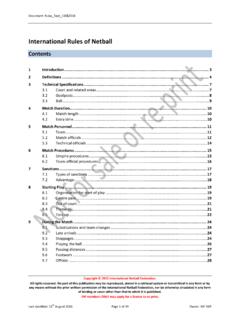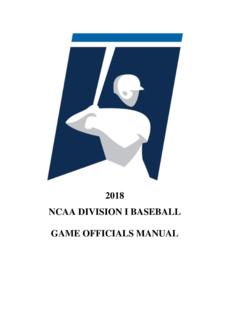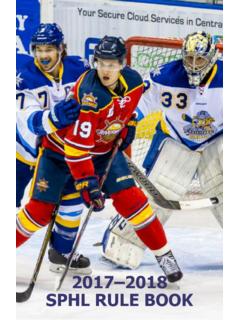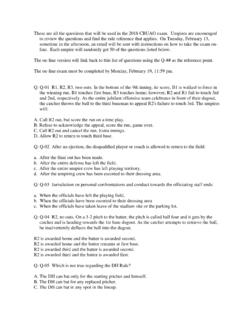Transcription of International Rules of Netball effective from 1
1 Document: Rules_Text_31102017. International Rules of Netball effective from 1st January 2018. Contents 1 3. 2 Definitions .. 4. 3 Technical 7. Court and related areas .. 7. Goalposts .. 8. Ball .. 9. 4 Match 10. Match length ..10. Extra time ..10. 5 Match Personnel .. 11. Team ..11. Match officials ..12. Technical officials ..14. 6 Match Procedures .. 15. Umpire Team official procedures ..16. 7 Sanctions .. 17. Types of sanctions ..17. 8 Starting Play .. 19. Organisation for start of play ..19. Centre pass ..19. Out of court ..21. Throw Toss 9 During the Match .. 24. Substitutions and team changes ..24. Late arrivals ..24. Stoppages ..24. Playing the ball ..26. Passing distances ..27. Footwork ..27. Offside ..28. Copyright 2015 International Netball Federation. All rights reserved. No part of this publication may be reproduced, stored in a retrieval system or transmitted in any form or by any means without the prior written permission of the International Netball Federation, nor be otherwise circulated in any form of binding or cover other than that in which it is published.
2 INF members ONLY may apply for a licence to re-print. st Last modified: 31 October 2017 Page 1 of 39 Owner: INF RAP. Document: Rules_Text_31102017. 10 Scoring a Goal .. 29. Requirements for scoring a goal ..29. Requirements for taking a shot ..29. 11 30. Obstruction of a player in possession of the ball ..30. Obstruction of a player not in possession of the Defence involving a player outside the court ..31. 12 Contact .. 32. Contact and contest ..32. Interference ..32. 13 Game Management .. 33. Actions that may be taken by Foul play ..34. Discipline of team officials and bench players ..36. 14 Umpire Hand Signals .. 37. 15 Variations for Other Levels of Play .. 39. Teams ..39. Equipment ..39. Time ..39. Match and technical Matches for young players ..39. Copyright 2015 International Netball Federation.
3 All rights reserved. No part of this publication may be reproduced, stored in a retrieval system or transmitted in any form or by any means without the prior written permission of the International Netball Federation, nor be otherwise circulated in any form of binding or cover other than that in which it is published. INF members ONLY may apply for a licence to re-print. st Last modified: 31 October 2017 Page 2 of 39 Owner: INF RAP. Document: Rules_Text_31102017. 1 Introduction Netball is an exciting, fast and skilful game of fair contest. It is a game in which two teams of seven players each strive to keep or gain possession of the ball. The team with the ball, through running, jumping, throwing and catching, attempts to move the ball into its goal circle from where a goal may be scored, while the opposing team uses defensive movements and strategies to prevent this and to gain possession.
4 The team with the greater number of goals is the winner of the match. Players have specified areas in which they can move. Play restarts after each goal with teams having alternate possession. The Rules are based on the core values of equal opportunity, fair play and respect for an opponent's skill and safety. It is the responsibility of players to ensure that they are physically and technically prepared in a manner that enables them to play the Game, comply with the Rules and participate safely in a sporting and fair manner. It is the responsibility of those who coach or teach the Game to ensure that players are prepared in a manner that ensures compliance with the Rules of the Game as well as an understanding of both sporting behaviour and safe practices. It is the responsibility of umpires to apply the Rules of the Game with impartiality, fairness and consistency.
5 It is the responsibility of controlling bodies at all levels to ensure that the Game is conducted and developed in accordance with disciplined and sporting behaviour. While Netball developed first as a game predominantly played by women and girls, it is now played by boys and girls, women and men. The Rules are written for International play. Variations in some Rules may be made locally for players of different levels or to meet other conditions (refer Section 15). INF publishes the Rules of Netball in several different languages. If there is divergence in wording, the English text is authoritative. Copyright 2015 International Netball Federation. All rights reserved. No part of this publication may be reproduced, stored in a retrieval system or transmitted in any form or by any means without the prior written permission of the International Netball Federation, nor be otherwise circulated in any form of binding or cover other than that in which it is published.
6 INF members ONLY may apply for a licence to re-print. st Last modified: 31 October 2017 Page 3 of 39 Owner: INF RAP. Document: Rules_Text_31102017. 2 Definitions A. Astride the transverse line: standing with one foot in the goal third and one foot in the centre third At the team bench: on or immediately beside (including behind or in front of) the team bench Attacking team: team that has possession of the ball B. Bench player: a player who is on the team bench at a given time during a match Bench zone: area immediately outside the court surround where the official bench, team benches and umpires' bench are located (all on the same side of the court). Breaking: early entry by a player to a third before the whistle is blown for a centre pass C. Caution: inform a player regarding that player's infringing and/or behaviour Controlling umpire: umpire in whose half play is at a given time Co-umpire: umpire who is not controlling play at a given time Court surround: area immediately surrounding the court D.
7 Defending team: team not in possession of the ball During play: at any time during a quarter/half except when time is held E. Event organiser: person/s with responsibility for the organisation of the match Extra time: an additional period of time used when the scores are tied at full-time and a winner is required F. Fake pass: player makes passing action but does not release ball Field of play: area consisting of the court and the court surround Free pass: sanction for a minor infringement Full-time: end of the specified playing time for a match (60 minutes) excluding any extra time G. Game: the Game of Netball Goal end: end of the court where a team shoots for goal Good sportsmanship: level of behaviour that meets generally accepted ethical standards in sport, including playing by the Rules , self-discipline, self-control and respecting opponents and officials H.
8 Half-time: interval between second and third quarters, in extra time the interval between the two halves I. INF: the International Netball Federation Infringement: action contrary to the Rules that may be penalised by an umpire International play: a match between two countries played for INF ranking points Interval: period of time between successive periods of play L. Landing foot (one foot landing): foot on which a player either first lands after catching the ball or is standing on when the ball is caught Landing foot (two feet landing): the foot NOT first moved when a player either catches the ball standing on both feet or lands on both feet simultaneously after catching the ball Copyright 2015 International Netball Federation. All rights reserved. No part of this publication may be reproduced, stored in a retrieval system or transmitted in any form or by any means without the prior written permission of the International Netball Federation, nor be otherwise circulated in any form of binding or cover other than that in which it is published.
9 INF members ONLY may apply for a licence to re-print. st Last modified: 31 October 2017 Page 4 of 39 Owner: INF RAP. Document: Rules_Text_31102017. M. Major infringement: infringement of the contact or obstruction Rules or when the goalpost is knocked causing a shot to miss Match: contest between two teams played according to the Rules of the Game Match officials: two umpires and a reserve umpire Minor infringement: infringement of the Rules governing playing the ball, footwork, centre pass, offside and other related Rules N. Natural body stance: being stable and upright, whether standing or moving, it may include slight arm movements for stability or momentum O. Official bench: place where the scorers and timekeepers are located during a match Opponent: player from the opposing team P.
10 Pass: action of player throwing, batting or bouncing the ball to a player Penalty pass: sanction for a major infringement or for foul play Period of play: a quarter in a match or a half in extra time Pivot: a movement where the player with the ball swivels either on the heel or on the ball of the landing foot while this maintains contact with the original landing position Playing enclosure: area consisting of the court, the court surround and bench zone Playing time: time elapsed in a quarter/half not including any stoppages Possession: player holds the ball with one or both hands Primary care person: team official who is qualified to diagnose and treat injury or illness (for example doctor or physiotherapist). R. Reserve umpire: match official seated at the umpires' bench who is ready to replace an umpire in the event of illness/injury during a match Retaliation: player's inappropriate response to the action/s of another player S.







